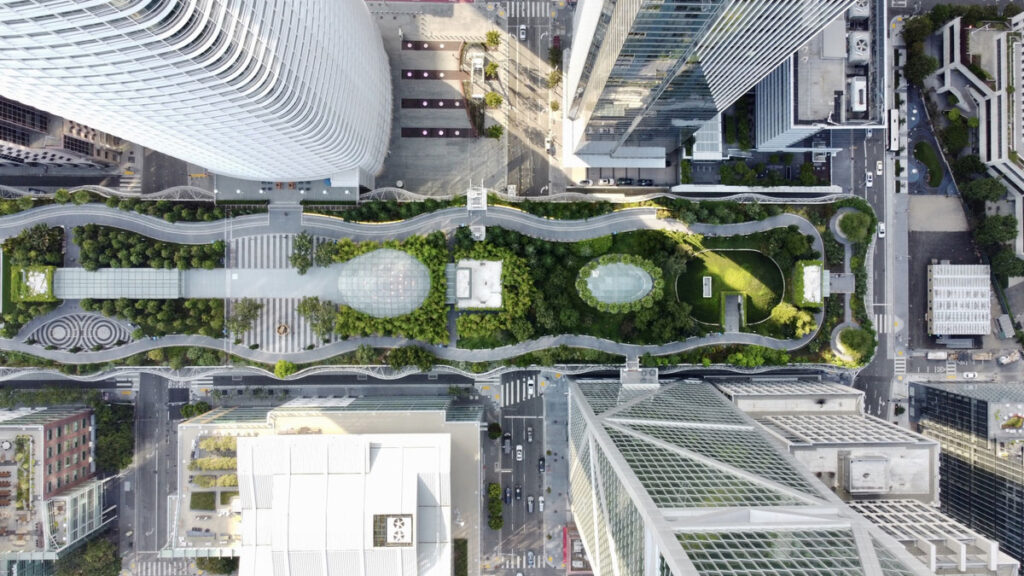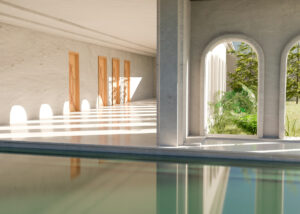Exclusive Neuroject Article: Sustainability has swiftly risen to prominence within the construction industry, driven by the pressing need to reduce environmental impact. Recent advancements in technology have made it easier than ever to gather data on emissions and other ecological factors, making sustainability an imperative focus for construction companies.
The significance of embracing sustainable construction technologies is underscored by the rapid expansion of sustainability reporting requirements for companies and mandatory disclosures by financial services firms. Competitiveness within the industry hinges on a dual understanding: recognizing the vital role of sustainability and appreciating the positive outcomes stemming from the fusion of sustainable construction technologies.
Sustainable construction technologies reach beyond the reduction of emissions and the cultivation of a positive public image, although these remain essential aspects. It carries far-reaching consequences. It profoundly influences the environment, global community well-being, the labor shortage in the construction sector, and the prospects for future projects. For any company aiming to secure a future in the industry, an investment in green construction is imperative. Initiatives within green construction are driving innovations and strategies that substantially diminish environmental footprints. Moreover, they yield financial savings, bolster corporate reputations, and lead to the development of state-of-the-art buildings and infrastructure.
Enhanced sustainable construction technologies efforts also hold the potential to attract young talents to the construction field. Research shows that Gen Z’s career choices are significantly influenced by environmental concerns. Construction companies aligning with sustainable practices can play a pivotal role in addressing labor shortages.
Table of Contents
An Overview of Sustainable Construction Technologies
Concurrently, sustainable construction technologies in materials and offsite construction techniques contribute to improved building performance and durability, all the while reducing emissions and transportation expenses. Circular construction and immersive construction employ intelligent design and digital tools to optimize the lifecycle of buildings and enhance the user experience.
Furthermore, reductions in waste and emissions translate directly into cost savings. Optimizing fuel consumption to reduce emissions not only contributes to environmental welfare but also results in financial benefits. Efficient resource utilization enhances material spending and elevates the return on investment for projects. This approach not only impresses clients but also caters to a growing demand for sustainability among consumers and stakeholders.
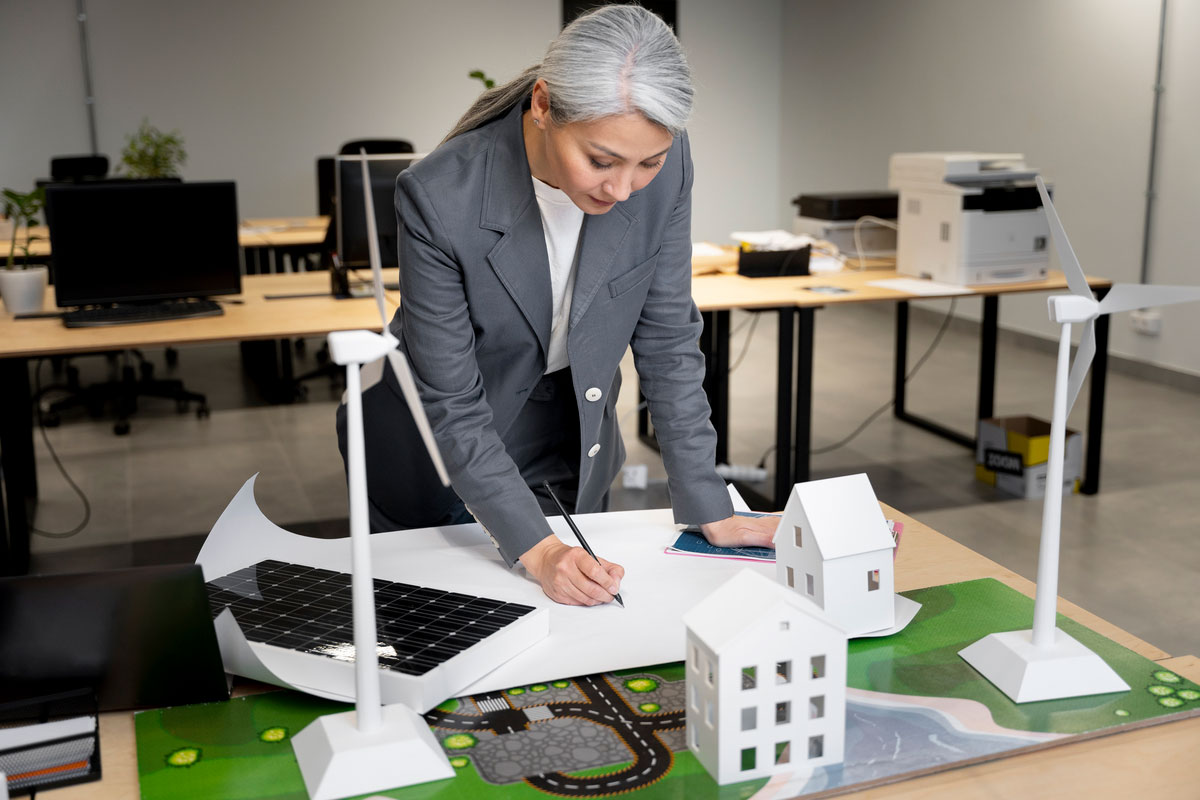
What are the Future Sustainable Construction Technologies?
As the world confronts the pressing challenges of climate change, the construction industry finds itself in a pivotal position to mitigate carbon emissions and champion sustainability. The growing call for environmentally responsible buildings and infrastructure has spurred construction firms to seek out fresh and inventive methods for sustainable construction.
In this industry report, we present the top 24 sustainable construction technologies, derived from our analysis of 3,405 startups and scaleups. These trends span from integrated environmental assessments (IEAs) and energy-efficient architectural designs to zero-waste construction, biophilic architecture, and rain gardens.
1. 3D Printing
In the construction industry, 3D printing offers a means to reduce material wastage, expedite production, and augment design flexibility in the sustainable construction technologies sector. Emerging companies are leveraging this technology to pioneer innovative solutions in eco-friendly construction. These solutions encompass the use of concrete printing and additive manufacturing to fabricate environmentally conscious construction materials.
Furthermore, they involve the development of larger 3D printers capable of constructing entire building structures. These printers also enable on-site fabrication of building components, allowing for the creation of intricate shapes and designs in the sustainable construction technologies sector. Some 3D printers even use self-healing materials to repair damages.
Black Buffalo 3D Revolutionizes Construction with 3D Printing
Black Buffalo 3D, a US-based startup, has introduced the NEXCON construction printers designed for commercial and housing projects. These printers employ proprietary concrete ink to produce sustainable infrastructure on demand. Their built-in controls facilitate the easy incorporation of electrical, plumbing, and other essential components in the sustainable construction technologies sector. The structures produced by these printers surpass the strength, durability, and safety standards of conventional mortars, presenting cost-efficiency and sustainability benefits to builders, contractors, and developers through waste reduction.
Mobbot Enhances 3D Concrete Spraying with Digitization
Mobbot, a Swiss startup, has developed a platform for digitizing the shotcrete process. This Internet of Things (IoT) solution interfaces with spraying machines, collecting data from their sensors and displaying it on a cloud-based dashboard. This real-time visibility of shotcrete operations optimizes the process, improves quality, and allows companies to enhance safety, productivity, and sustainability by reducing concrete usage and CO2 emissions in the sustainable construction technologies sector.
Suggested articles to read: 3D Printing in Construction | 11 Examples of 3D Printed Houses
2. Integrated Environmental Assessments
Integrated Environmental Assessments (IEAs) enable the evaluation and reduction of environmental impacts throughout a building’s lifecycle in the sustainable construction technologies sector. This process involves utilizing Building Information Modeling (BIM) for comprehensive visualization and Life Cycle Assessment (LCA) to gauge the environmental effects of construction materials and processes.
Startups are harnessing IEAs to develop digital tools for data collection and analysis, with a primary focus on assessing the environmental impact of materials, energy consumption during construction, and effects on ecosystems and communities. These assessments aid in comparing design alternatives and optimizing a building’s environmental performance in the sustainable construction technologies sector.
Cercula Provides Carbon Metrics with Life Cycle Assessment Software
Cercula, a UK-based startup, offers life cycle assessment software for building projects, facilitating carbon metric generation and reporting in the sustainable construction technologies sector. The software streamlines the workflow, providing instant carbon metrics from cost plans and bills of quantities, along with additional features such as portfolio organization, analysis, and compliance with regulations. This empowers property developers, contractors, architects, and sustainability professionals to efficiently deliver projects that align with climate targets.
Hloov Introduces a Decision Intelligence Platform with Digital Twins
Hloov, a UAE-based startup, has developed Tagwaye, a human-centric AI-driven living digital twins platform in the sustainable construction technologies sector. It empowers stakeholders in the built environment with decision intelligence to make informed and complex decisions confidently. This platform enhances asset management, offering an integrated view of all assets throughout a project’s lifecycle, optimizing operational performance, reliability, and safety. Hloov supports businesses in minimizing waste and reducing the adverse environmental impacts associated with the built environment.
3. Construction Robots
Robotics play a pivotal role in enhancing sustainability and efficiency in the sustainable construction technologies industry. They are utilized for tasks like site inspection and precision demolition. Robots and drones conduct site inspections, gathering data to monitor progress, safety, and quality.
Demolition robots dismantle structures and materials with precision and speed, minimizing noise and dust. Several startups are pioneering innovative technologies for construction robots, integrating AI, computer vision, and wireless communication to significantly reduce construction waste and enhance overall efficiency, thereby resulting in economic and sustainability benefits.
Curvecrete Revolutionizes Concrete Paneling with Robotics
Curvecrete, an Australian startup, specializes in curved concrete paneling using low-carbon concrete and robotic forming sustainable construction technologies. Their casting method employs an adjustable and reusable single mold, enabling customization of panel curvature and texture. This not only reduces emissions and waste but also introduces curved architectural elements suitable for both indoor and outdoor installations.
These panels are fire-rated and sealed, offering architects, contractors, and developers a means to incorporate sustainable and aesthetically pleasing design elements into their projects in sustainable construction technologies.
ROBOSURF Enhances Surface Finishing with Autonomous Robots
ROBOSURF, an Italian startup, manufactures autonomous mobile robots (AMRs) designed for surface finishing and paint applications in construction. These robots leverage AI and Industry 4.0 technologies to automate tasks like sanding and spray painting. The startup also offers multiple applications for the robot, enabling flexible and safe operations in challenging conditions, leading to improved efficiency, flexibility, and safety at construction sites.
Suggested article to read: Construction Robots in 2024
4. Energy-Efficient Architecture
Energy-efficient architecture seeks to minimize the environmental impact of buildings while optimizing their performance. Passive design, which leverages natural elements like sunlight, wind, and vegetation, regulates indoor temperature and lighting. It also incorporates green roofs and walls, providing insulation, managing stormwater, and promoting biodiversity in sustainable construction technologies.
Energy-efficient architecture involves the use of efficient heating, ventilation, and air conditioning (HVAC) systems to reduce energy consumption and greenhouse gas emissions. Startups are developing smart sensors and energy management systems to enhance occupant health, comfort, and well-being.
Eden Arc Advances Energy-Efficient Construction
Eden Arc, a UK-based startup, offers solutions for designing immersive outdoor experiences with eco-friendly materials and green construction technologies. Their products include buildings with low-impact foundations, sedum grass roofs, and cladding sourced from sustainable materials.
Additionally, they provide an optional off-grid power supply package featuring solar and battery storage. The startup’s structural insulated panels (SIPs) modular construction method allows for a diverse mix of room types with customizable finishes and specifications.
Thermosphr Optimizes Building Thermal Management with Software
Thermosphr, a German startup, develops software solutions to enhance thermal efficiency in buildings, utilizing thermal modeling technology and real-time building communication. Their services encompass Software as a Service (SaaS) for real-time HVAC control, predictive maintenance, and equipment performance monitoring.
The startup customizes its model for each building, predicting indoor temperature variations, modeling HVAC equipment efficiency, and calculating optimized HVAC settings. It enables remote adjustment of HVAC settings with predictive control technology, leveraging existing building management system (BMS) data and introducing a thermal digital twin technology to deliver insights on building performance, ensuring maximum energy efficiency by automating HVAC management.
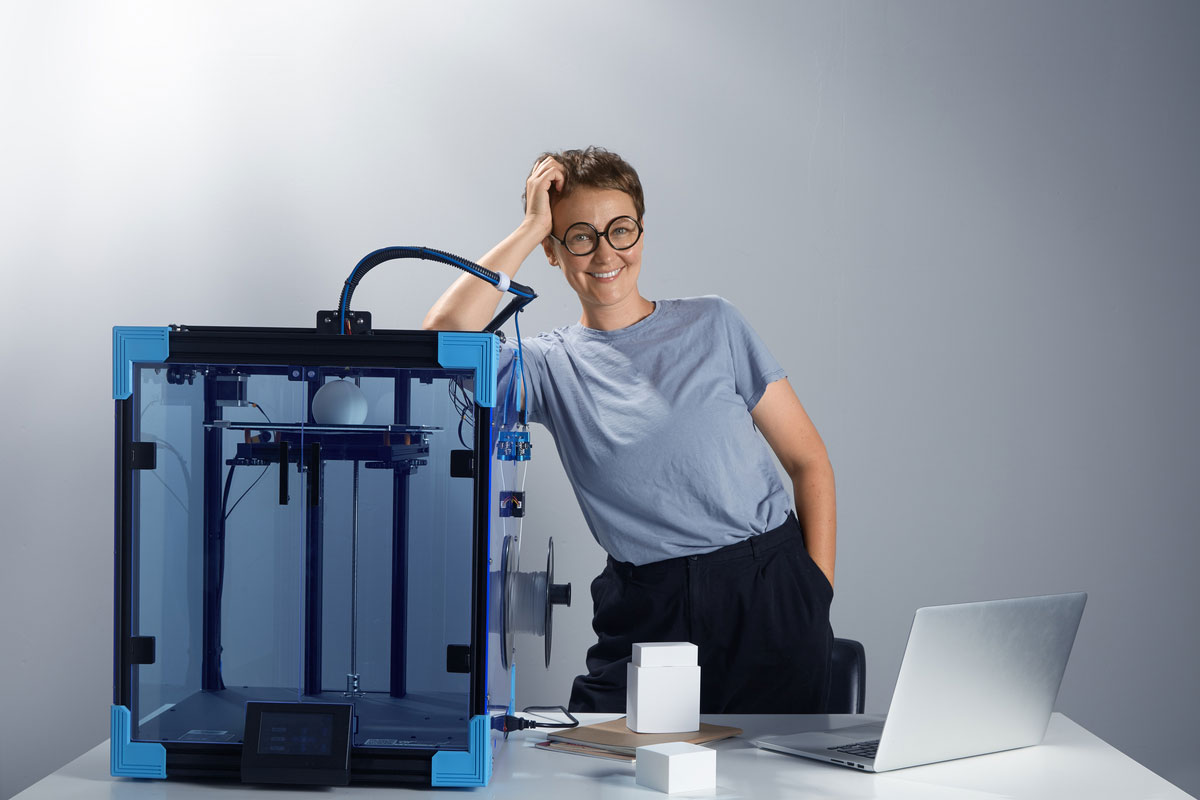
5. Sustainable Construction Materials
Sustainable construction materials aim to reduce the environmental impact of buildings and infrastructure by using eco-friendly and renewable resources. This includes recycled and reclaimed materials like steel, wood, glass, and plastic, which not only reduce waste but also replace virgin raw materials. Bio-based materials such as bamboo, hemp, and straw, which are both renewable and biodegradable, are part of this category.
Low-carbon concrete is another sustainable material that uses less cement and incorporates additives to lower greenhouse gas emissions. Startups are at the forefront of creating more efficient, durable, and cost-effective green construction materials, promoting eco-friendly construction practices in the sustainable construction technologies sector.
EcoBricks Transforms Plastic Waste into Eco-friendly Concrete
EcoBricks, based in Hong Kong, specializes in converting plastic waste into sustainable concrete. Their innovative process accepts all types of plastic, including mixed plastics, without emitting pollutants or greenhouse gases. The eco-friendly concrete bricks they produce have a lower carbon footprint compared to conventional ones. EcoBricks not only offers a locally sourced solution but also contributes to circularity in plastic waste management, reducing the carbon footprint of the sustainable construction technologies industry.
Aisti Manufactures Sustainable Acoustic Tiles
Aisti, a Finnish startup, focuses on sustainable acoustic solutions using natural and carbon-negative materials. Their product, Teno Acoustic Tile, is crafted from wood fiber and is entirely recyclable. These tiles boast a negative carbon footprint thanks to their energy-efficient production process. Aisti utilizes foam-forming technology to create low-density tiles that are free from synthetic binders, allergens, and plastic. By offering eco-friendly products, Aisti empowers construction companies to make environmentally responsible choices and reduce their carbon footprint in the sustainable construction technologies industry.
Suggested article to read: Top 10 Green Building Materials
6. Offsite Construction
Offsite construction entails the manufacturing of building components in a controlled environment before transporting them to the construction site. This method ensures consistent production and higher quality standards compared to on-site construction, which is often subject to weather conditions. Prefabrication and modular construction techniques minimize waste, enhance quality control, and reduce construction time.
Digital technologies further improve efficiency, reduce waste, and enhance accuracy in offsite construction. Startups are actively developing offsite construction solutions that prioritize efficiency and eco-friendliness, benefiting both the environment and the sustainable construction technologies industry.
Sweelco Advances Off-Site Building Design
Sweelco, a French startup, is at the forefront of offsite construction for the sustainable construction technologies industry. Their approach involves modular construction, integrating digital building designs with automated prefabrication and on-site assembly. Sweelco leverages a light steel frame to offer a faster, more efficient, and more sustainable construction process. This approach provides contractors and construction companies with high-quality results while minimizing waste and material usage.
Offsight Facilitates Off-Site Project Management
Offsight, a US-based startup, specializes in manufacturing project management software for offsite construction and the building industry. Their software addresses production, quality, traceability, and communication challenges in offsite and project-based manufacturing.
A live production dashboard allows managers to track production progress and quality in real-time, detect assembly errors, minimize costly factory rework, and delegate tasks efficiently. The software also offers robust reporting capabilities to track non-conformance and production progress, optimizing factory operations and increasing efficiency in the sustainable construction technologies industry.
7. Zero Waste Construction
Zero waste construction is a sustainability approach aimed at eliminating or minimizing construction and demolition waste throughout the building lifecycle. This involves using non-toxic and biodegradable materials, optimizing material usage, and integrating design and construction processes to reduce waste. Recovering and downcycling construction waste materials, such as concrete, bricks, and asphalt, is a strategy to reduce waste.
Additionally, deriving energy from waste by using it as fuel for electricity not only lowers environmental impacts but also reduces costs, enhances quality, and adds social value to the sustainable construction technologies industry.
Adaptis Facilitates Building Decarbonization
Adaptis, a Canadian startup, has developed software that combines data-driven evaluation, reuse planning, and design for decarbonizing cities. Their algorithm factors in material salvage value, reuse calculations, deconstruction planning, and adaptation design feasibility to optimize and automate adaptation planning for environmental and economic factors. Adaptis improves existing condition assessments and building adaptation planning, ultimately reducing the carbon footprint of buildings.
Upcycling Forum Provides Upcycled Construction Materials
Upcycling Forum, a Danish startup, has created a digital platform to facilitate upcycling for businesses and enable the measurement of CO2 effects, savings, and other metrics. This platform transforms discarded materials and products, typically considered waste, into new items with greater value than the originals. Upcycling Forum’s offerings include project packages and a project tool, along with an app that allows stakeholders to buy and sell new materials. By doing so, the startup aids producers and construction businesses in reducing waste and CO2 emissions while optimizing reuse and deconstruction planning.
8. Circular Construction
Circular construction is a sustainable approach that focuses on eliminating waste and regenerating nature through the design, production, and circular consumption of goods in the sustainable construction technologies industry. It incorporates renewable energy sources, designs for disassembly, and emphasizes lifecycle thinking to reduce environmental impact.
Startups are actively contributing to circular construction through modular building systems, circular bridges, and sustainable paints and coatings. These innovations facilitate the reuse and recycling of materials, extend product lifecycles, and enhance energy efficiency in the sustainable construction technologies industry.
Our Ecolution Transforms Agricultural Waste into Circular Building Materials
Our Ecolution, a Swedish startup, is dedicated to converting agricultural waste into affordable and eco-friendly building systems in the sustainable construction technologies industry. They have developed OSE Boards with exceptional strength-to-weight ratios, thermal and acoustic insulation properties, and fire resistance.
These boards find application in various building and construction projects, offering sustainable building materials that significantly reduce greenhouse gas emissions, waste, and pollution in the sustainable construction technologies industry.
FenX Designs Recyclable Insulation Materials from Mineral Waste
FenX, a Swiss startup, specializes in converting mineral waste into sustainable and high-performance insulation for the construction industry. They create recyclable insulation foams using mineral waste, with minimal CO2 emissions generated during manufacturing. FenX offers a product line that includes bricks, panels, and customized parts, all featuring insulation, temperature resistance, and adjustable porosity. By advancing the circular economy, FenX provides eco-friendly and efficient insulation solutions to the sustainable construction technologies industry.
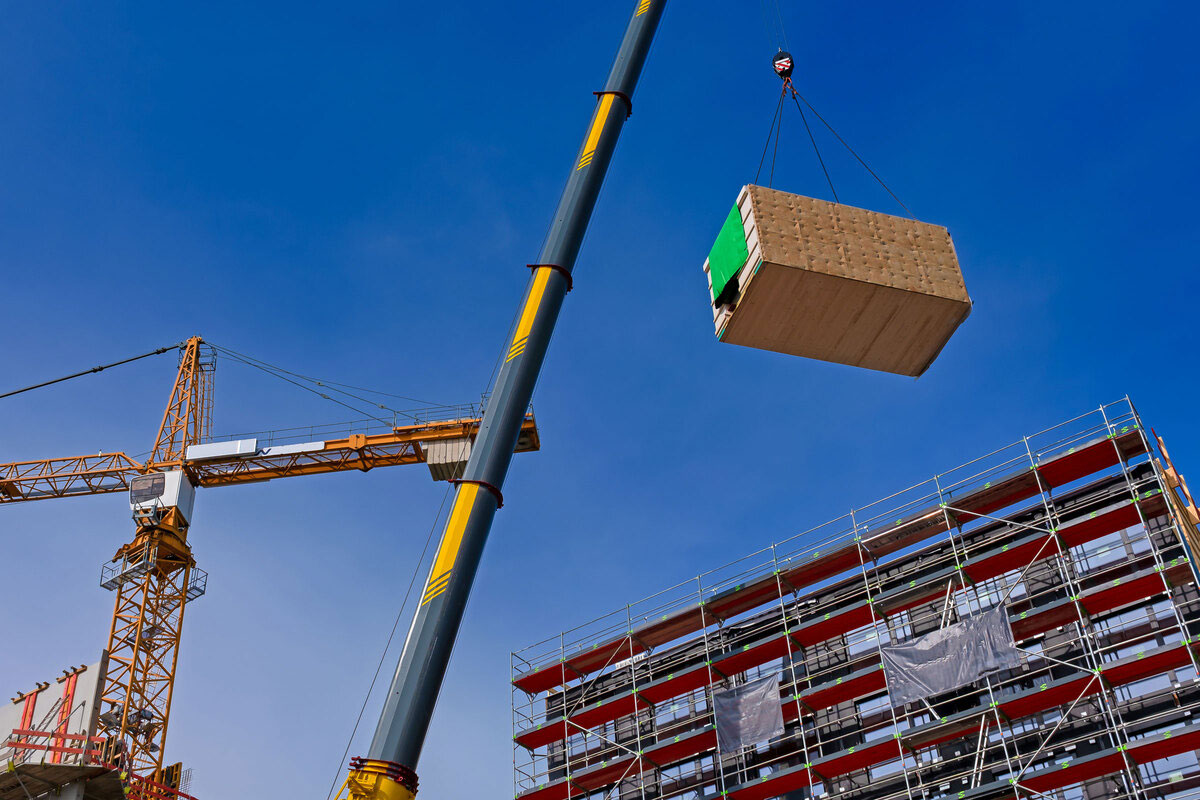
9. Biophilic Architecture
Biophilic architecture aims to connect people with nature within the built environment, enhancing occupant well-being while minimizing the environmental impact of buildings. It emphasizes the use of natural materials like wood, stone, and bamboo, as well as the integration of green spaces such as gardens, terraces, and green roofs.
Furthermore, it maximizes natural light through large windows, skylights, and solar tubes. Startups are contributing to this trend by developing biometric sensors, smart lighting, and ventilation systems, creating healthier and more resilient spaces in the sustainable construction technologies industry.
Advanced Autoponics Enhances Building Plant Management with Modular Hydroponics
Advanced Autoponics, a US-based startup, offers a modular hydroponic and aeroponic system that simplifies plant growing in biophilic and commercial settings. Their technology uses innovative modules that allow developers, designers, and architects to incorporate plants anywhere, without the limitations of soil.
This approach creates an optimal root environment for plant growth while conserving water and space. The sustainable construction technologies also offer real-time monitoring from anywhere in the world, allowing designers to seamlessly integrate plants into architectural designs while optimizing indoor foliage health and reducing the need for hands-on maintenance in the sustainable construction technologies industry.
Natura Enhances Urban Spaces with Plantscaping
Natura, an Indian startup, provides plantscaping solutions to create biophilic environments. Their comprehensive services include design, manufacturing, installation, and maintenance programs. Natura’s plant features bring the beauty of greenery and blooms to outdoor areas, building facades, and indoor spaces. By improving air quality and aesthetics, Natura contributes to mitigating the adverse effects of climate change, transforming urban landscapes from gray to green. This enhances occupant well-being and productivity.
10. Immersive Construction
Immersive construction leverages digital technologies to enhance sustainability in the construction industry, facilitating collaboration, prototyping, visualization, and training. It creates virtual environments that simulate real-world scenarios, enabling more effective communication and coordination among stakeholders in the sustainable construction technologies industry.
Additionally, it allows for real-time visualization and exploration of projects and provides interactive and safe training for workers. Immersive construction technologies include virtual reality (VR), augmented reality (AR), mixed reality (MR), 3D modeling, cloud computing, and artificial intelligence (AI). Startups are developing platforms for remote collaboration, digital twin creation, and management to improve project planning and execution in the sustainable construction technologies industry.
GenieVision Enhances Work Site Management with AR Technology
GenieVision, a Belgian startup, provides an augmented reality (AR) solution for the construction industry. Their AR technology allows engineers and construction professionals to compare on-site conditions to 3D Building Information Modeling (BIM). This approach enables the early detection and correction of construction flaws, preventing them from becoming major failures. GenieVision’s user-friendly interface allows for quick on-site visualization of 3D models, streamlining field processes and enabling direct communication between on-site teams and management. It also provides georeferenced information for more effective planning by the sustainable construction technologies industry.
Virtual Building Empowers Construction Designs with VR
Virtual Building, an Estonian startup, focuses on VR-based solutions for the sustainable construction technologies industry. Their VR technology allows for 3D visualization of infrastructure and real estate, enabling clients and partners to experience future premises through VR headsets. Additionally, their AR technology simplifies the monitoring of construction progress.
The platform enables the design of construction sites, including various units within real estate, optimizing project planning and execution. This technology is particularly valuable for projects such as tunnels, roads, squares, parking lots, and other structures, offering improved project planning and execution in the sustainable construction technologies industry.
11. Green Roofs
Green roofs, also known as living roofs or vegetated roofs, represent an environmentally conscious technology that is increasingly integrated into construction projects. These innovative roofing solutions are not only practical but also visually appealing. Green roofs are designed to be adorned with a variety of vegetation, which can include grasses, shrubs, and even small trees, creating a lush and green urban oasis. Underneath the vegetation lies a carefully engineered system that includes a waterproof membrane and layers of soil or growing medium in the sustainable construction technologies industry.
The advantages of green roofs extend to both the environment and building occupants in the sustainable construction technologies industry. They provide a natural cooling effect through the process of evapotranspiration, reducing the urban heat island effect. Green roofs also capture and filter rainwater, reducing the load on stormwater systems and offering an additional water source for the vegetation. Moreover, they improve air quality by filtering pollutants and carbon dioxide from the air, creating a healthier living and working environment. Beyond these benefits, green roofs also offer a unique aesthetic appeal, contributing to the visual richness of urban landscapes.
GreenCo Roofs Pioneer in Sustainable Construction
GreenCo Roofs, a leading innovator in the field of green roofing, has developed cutting-edge green roof systems that are not only aesthetically pleasing but also highly efficient in the sustainable construction technologies industry. They offer modular green roofing solutions that can be easily integrated into construction projects. These modular systems are designed for easy installation and maintenance, making them a favorite among builders and architects. GreenCo Roofs’ commitment to sustainability extends beyond their products; they also provide extensive educational resources to promote the widespread adoption of green roofs.
Bauder Flat Roofs Provides PV and Green Roof Solutions
Suffolk-based Bauder Flat Roofs is a building company in the sustainable construction technologies industry. It offers premium photovoltaic, green roof, blue roof, and waterproofing solutions. It was established as a private business in 1857. The company makes waterproofing, insulation, blue roofs, green roofs, photovoltaics, and flat roofs. They provide premium PV and green roof solutions in addition to their waterproofing systems for flat roofs.
12. Solar Panels
Solar panels have emerged as a widely adopted and effective eco-friendly solution within the sustainable construction technologies industry. They harness the sun’s energy to generate electricity, reducing dependence on conventional fossil fuels and minimizing carbon emissions. Solar panels can be installed in various ways to suit different construction needs. They can be integrated seamlessly into rooftops, turning previously underutilized spaces into energy-generating surfaces. Stand-alone solar structures in the form of solar canopies or solar farms can also be incorporated into the construction project, offering a dependable renewable energy source.
One of the latest advancements in solar panel technology is the integration of solar cells directly into building materials. Roofing tiles, facades, and even windows can now be equipped with solar panels, offering an aesthetically pleasing and efficient sustainable energy solution. This innovation not only generates electricity but also enhances the overall energy efficiency of the building, making it a cost-effective and eco-friendly choice for builders and homeowners alike in the sustainable construction technologies industry.
SunTech Energy Highly Effective Solar Panels
SunTech Energy is a prominent player in the solar panel industry, known for its state-of-the-art solar technology and commitment to sustainability in the sustainable construction technologies industry. They produce highly efficient solar panels that are not only reliable but also aesthetically pleasing. SunTech’s solar panels are used in residential, commercial, and industrial projects worldwide. They continuously invest in research and development to improve solar efficiency, making their panels among the most advanced in the market.

13. GreenPower Innovations
GreenPower Innovations specializes in integrating solar panels into building materials, turning every surface into an energy-generating opportunity in the sustainable construction technologies industry. Their advanced BIPV (Building-Integrated Photovoltaics) solutions are widely recognized for their seamless integration into roofing tiles, windows, and facades. GreenPower Innovations collaborates with architects and construction firms to ensure that renewable energy generation becomes an inherent part of modern construction, making them a key player in the green building movement.
SolTech, Energy Revolutionizing Solar Heat Integration
SolTech Energy, a Swedish-based company, has been at the forefront of redefining how we harness solar power for heating purposes. They have developed an innovative solution called the “SolTech System,” which seamlessly integrates solar heating into building materials, such as roofing and walls. These aesthetically pleasing, glass roof tiles and wall panels not only capture sunlight but also convert it into heat energy for residential and commercial properties. This approach not only reduces reliance on conventional heating systems but also significantly lowers energy costs and carbon emissions. SolTech Energy’s commitment to blending sustainable technology with architectural aesthetics showcases its pioneering role in the green energy sector.
Tesla, A Force in Renewable Energy Solutions
Tesla, primarily known for its electric vehicles, has also made significant strides in the realm of renewable energy with its solar, energy storage products and the sustainable construction technologies industry. Their solar panels and solar roofs have redefined how homeowners generate electricity from the sun. These cutting-edge solar solutions, paired with Tesla’s energy storage products like the Powerwall and Powerpack, enable consumers to harness, store, and utilize clean energy efficiently.
Tesla’s comprehensive approach to energy solutions not only empowers individuals and businesses to reduce their carbon footprint but also promotes a more sustainable and resilient energy infrastructure. The company’s vision extends beyond just automobiles and positions it as a leader in the transition to green power innovations in the sustainable construction technologies industry.
14. Rainwater Harvesting
The rainwater harvesting system is a smart, sustainable practice that involves the collection of rainwater from roofs and other surfaces and storing it for later use in non-potable applications like irrigation and toilet flushing. This eco-friendly solution is becoming increasingly popular in construction projects, serving both environmental and practical purposes.
By collecting rainwater, construction projects can reduce their reliance on conventional water sources and decrease the demand for municipal water supplies. This results in lower water bills and a reduced environmental impact. Rainwater harvesting systems can be seamlessly integrated into the design of a building, making them both efficient and aesthetically pleasing. This technology aligns with a more sustainable and responsible approach to water resource management, contributing to a greener and more eco-conscious construction industry.
AquaSavers Rainwater Harvesting Technology
AquaSavers is a pioneer in the field of rainwater harvesting technology and the sustainable construction technologies industry. They offer comprehensive solutions for collecting, storing, and utilizing rainwater efficiently. Their systems are designed to be easy to install and maintain, making them a top choice for construction projects. AquaSavers not only provides practical rainwater harvesting solutions but also offers education and training to help builders and homeowners make the most of this sustainable water resource.
RainPure Systems Unique Purification Systems
RainPure Systems is known for its advanced rainwater filtration and purification technologies. They provide top-quality systems that ensure harvested rainwater is safe for various non-potable applications, including irrigation, toilet flushing, and more. RainPure’s systems are designed to meet the highest water quality standards while being energy-efficient, making them a go-to choice for eco-conscious construction projects.
15. Green Concrete
Green concrete, often referred to as sustainable or eco-friendly concrete, is a construction material engineered to mitigate the environmental impact of concrete production and utilization. Traditional concrete production can be highly energy-intensive and contribute to substantial carbon emissions. In contrast, green concrete employs more sustainable materials and processes to reduce its ecological footprint. Supplementary cementitious materials (SCMs) like fly ash, slag, or silica fume can replace a portion of the cement used in conventional concrete, curbing energy consumption and carbon emissions linked to cement production.
Moreover, the incorporation of recycled materials, such as crushed glass or recycled aggregate, reduces the need for virgin resources and diverts waste from landfills. Green concrete is not only environmentally responsible but also highly durable and functional. It can offer the same structural integrity as traditional concrete, making it a smart choice for sustainable construction technologies and projects.
EcoMix Concrete Friendly Concrete Solutions
EcoMix Concrete is a leading provider of environmentally friendly concrete solutions in the sustainable construction technologies industry. They have pioneered the use of supplementary cementitious materials (SCMs) in their concrete mixes, reducing the carbon footprint associated with concrete production. EcoMix Concrete offers a range of sustainable concrete products, including high-performance mixes that meet or exceed industry standards while minimizing environmental impact.
GreenStone Inc. Recycles Materials
GreenStone Inc. is a company that specializes in the production of green concrete using recycled materials. Their innovative approach includes incorporating recycled aggregates, reducing the demand for virgin resources. GreenStone’s commitment to sustainability goes beyond its products; it works with construction companies to ensure the responsible use of green concrete in various building applications, making it a trailblazer in sustainable construction materials.
16. Smart Lighting Systems
Smart lighting systems represent an innovative and environmentally conscious solution for the construction sector, aimed at decreasing energy consumption and promoting sustainability. These systems leverage advanced sensor and control technologies to optimize lighting levels and minimize energy wastage in the sustainable construction technologies industry. Occupancy sensors, for instance, can detect when a room is occupied and automatically adjust lighting, ensuring that lights are not needlessly left on in unoccupied spaces, thus reducing energy waste.
In addition to occupancy sensors, smart lighting systems can adapt to natural light conditions, dimming or brightening as needed, thus reducing electricity consumption. These systems are highly flexible and can be programmed to suit the specific needs of a building. Moreover, they often come with user-friendly interfaces and smartphone apps, allowing for convenient control and monitoring of lighting systems. The result is not only energy efficiency but also significant cost savings and a reduced environmental footprint, making smart lighting a forward-thinking choice in modern construction.
Enlightech Solutions Intelligent Lighting Systems
Enlightech Solutions is a pioneer in the development of intelligent lighting systems for the construction industry and the sustainable construction technologies industry. Their innovative products leverage advanced sensor technologies and machine learning algorithms to create lighting systems that adapt to user behavior and environmental conditions. Enlightech’s solutions not only reduce energy consumption but also enhance the quality of lighting in commercial and residential spaces, offering an all-encompassing approach to energy efficiency.
EcoLight Control Smart Lighting Control
EcoLight Control is at the forefront of smart lighting control systems in the sustainable construction technologies industry. They specialize in providing scalable, user-friendly solutions for buildings of all sizes. Their systems are designed to be easily integrated into construction projects, offering an intuitive interface for controlling and monitoring lighting. EcoLight Control is known for its commitment to sustainability and its contribution to reducing energy waste through efficient lighting control, making it a leader in the smart lighting sector.
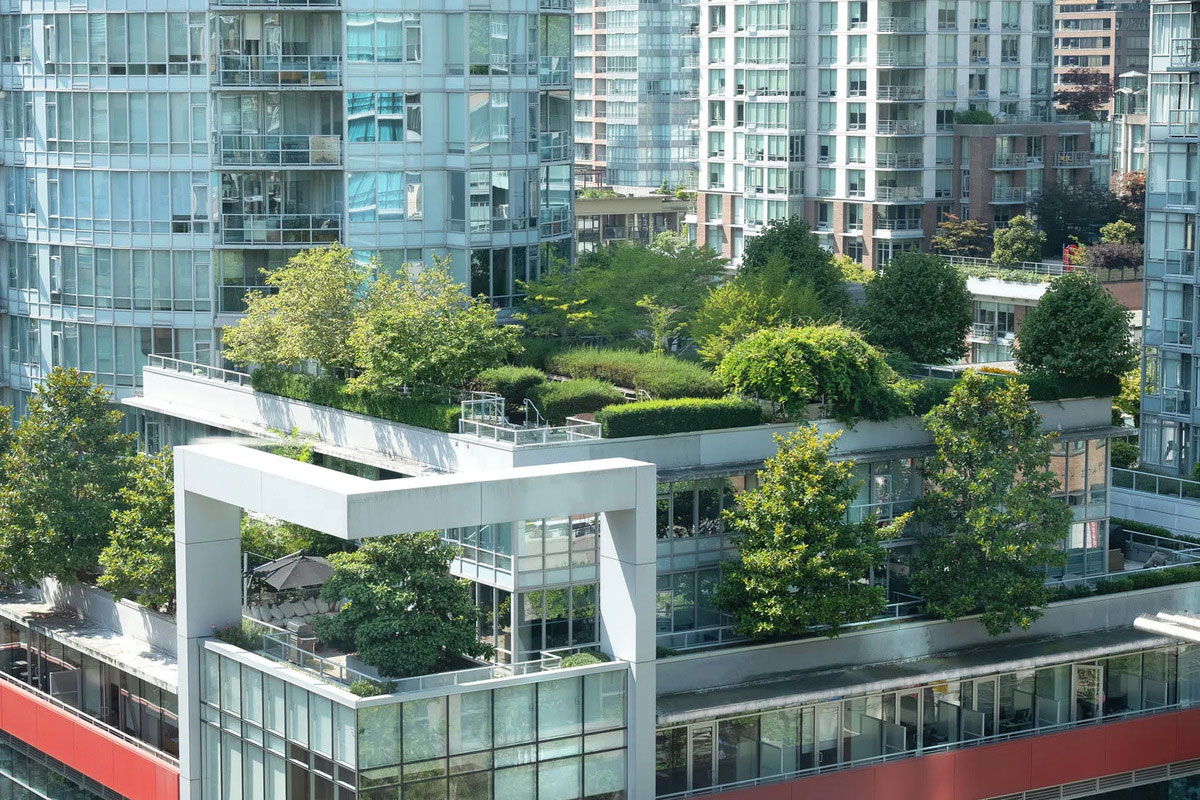
17. Cool Roofs
Cool roofs, a remarkable innovation in eco-friendly construction, are designed to reflect a greater amount of sunlight and absorb less heat compared to conventional roofing materials. By employing reflective materials that bounce back a substantial portion of the sun’s rays, cool roofs play a pivotal role in maintaining cooler building temperatures. This, in turn, significantly reduces the demand for energy-intensive cooling systems, leading to cost savings and environmental benefits for the sustainable construction technologies industry.
Traditional roofing materials, such as asphalt or tar, tend to absorb a substantial amount of solar heat, thereby elevating indoor temperatures and escalating the need for energy-consuming cooling solutions. In sharp contrast, cool roofs act as a shield against excessive heat absorption, thereby promoting a comfortable and energy-efficient interior environment. This technology stands as a prime example of how eco-friendly construction practices are evolving to tackle the challenges of energy consumption and climate change.
GAF Energy the Future of Roofing
GAF Energy is a leading company in the field of cool roofs in the sustainable construction technologies industry. They have developed innovative solar roofing solutions that combine cool roofing materials with solar panels, effectively turning roofs into sources of renewable energy. This integration not only reflects sunlight but also generates electricity, further reducing a building’s energy consumption.
SolarCity Solar Tiles and Cool Roofing at the Same Time
Acquired by Tesla, SolarCity is renowned for its solar roofing solutions in the sustainable construction technologies industry. They have pioneered the use of solar tiles that are not only energy-efficient but also aesthetically pleasing. By combining cool roofing technology with solar power, SolarCity is at the forefront of creating sustainable and cool roofing systems.
18. Living Walls
Living walls, often referred to as green walls, stand as a testament to the innovative and environmentally conscious solutions that are reshaping the construction industry. These vertical gardens, adorned with an array of plant life, have transcended the conventional notions of architectural aesthetics. Not only do they infuse a strikingly natural and vibrant aspect into building designs, but they also offer a myriad of environmental advantages.
One compelling feature of living walls is their ability to enhance air quality. The plants incorporated within these verdant walls are natural air purifiers, absorbing pollutants and releasing oxygen, thereby contributing to a healthier indoor environment. Additionally, living walls play a significant role in mitigating the urban heat island effect, as the vegetation serves as a natural insulator, reducing the heat absorbed by building surfaces. These eco-friendly vertical gardens are not merely a decorative addition but a manifestation of sustainability within urban spaces.
AeroFarms Sustainable Indoor Agriculture
Based in Newark, New Jersey, AeroFarms is a sustainable indoor agricultural company that grows vegetables using a unique aeroponic growing technique. At the moment, the business owns and runs four farms in and around Newark.
Sagegreenlife Smart Technologies and Selected Plants
Sagegreenlife, located in the United States, specializes in creating sustainable living wall systems. Their approach combines smart irrigation technology with carefully selected plant species, ensuring the long-term health and vitality of living walls in diverse environments in the sustainable construction technologies industry.
19. Water-Efficient Fixtures
In the realm of eco-friendly construction, water-efficient fixtures have emerged as vital components aimed at curbing water consumption and advancing the cause of sustainability. These fixtures, which encompass low-flow toilets, faucets, showerheads, and urinals, are ingeniously engineered to strike a balance between conserving water and maintaining optimal performance.
In the face of growing concerns about water scarcity and environmental impact, water-efficient fixtures represent an intelligent response. By significantly reducing water usage without compromising functionality, they not only save water resources but also cut utility costs. As eco-consciousness continues to drive construction practices, these fixtures have transitioned from being mere accessories to becoming pivotal tools in building sustainable, water-smart structures.
WaterSmart Innovations: Revolutionizing Water Conservation
WaterSmart Innovations, a visionary company at the forefront of the eco-friendly construction movement, has made a substantial impact with its cutting-edge water-efficient fixtures. Their low-flow toilets, in particular, stand as a testament to their commitment to resource preservation. These toilets utilize innovative flushing technology that significantly reduces water usage while still ensuring an effective flush. By incorporating their fixtures into commercial and residential buildings, WaterSmart Innovations has been a game-changer in the quest for water conservation without sacrificing convenience.
AquaSolutions: Advancing Sustainable Water Management
AquaSolutions is another pioneering company dedicated to advancing sustainable water management within the construction industry. Their line of water-efficient fixtures, including faucets and showerheads, is designed to optimize water usage without compromising performance. AquaSolutions is on a mission to equip construction projects with tools that minimize water waste, making eco-friendly buildings the standard for the future. By integrating their fixtures, developers, and homeowners can not only reduce their water bills but also play a crucial role in preserving our planet’s most precious resource.
20. Biodegradable Materials
Biodegradable materials have emerged as a sustainable and eco-friendly alternative in the construction industry, offering a promising solution to mitigate the negative environmental impact traditionally associated with standard building materials. These innovative materials are derived from natural resources that have the remarkable ability to decompose and reintegrate into the environment without causing harm.
For instance, bamboo, renowned for its rapid growth, stands out as a renewable resource with impressive qualities: it is both lightweight and robust. Its applications in construction are diverse, ranging from eco-friendly flooring and wall panels to scaffolding that is both strong and eco-conscious. Furthermore, bamboo’s exceptional carbon dioxide absorption surpasses that of most tree species, significantly reducing the carbon footprint of construction projects that embrace it.
EcoMats Revolutionizes the Sustainable Construction Technologies
EcoMats, a leading company in the field of biodegradable construction materials, is revolutionizing the industry with its innovative products in the sustainable construction technologies industry. They produce biodegradable mats and panels made from natural fibers like coir, jute, and hemp. These materials serve as an eco-friendly alternative to traditional construction materials. EcoMats’ products are not only biodegradable but also offer excellent durability and insulation properties, making them a sustainable choice for various construction applications.
BioBrick Co. Carbon Nuetral Materials
BioBrick Co. is at the forefront of creating biodegradable bricks that are designed to replace traditional clay or concrete bricks in the sustainable construction technologies industry. Their innovative technology utilizes organic waste materials, such as agricultural residues and food waste, to produce eco-friendly building blocks. These biodegradable bricks not only reduce the carbon footprint of construction but also actively contribute to waste reduction and resource conservation.
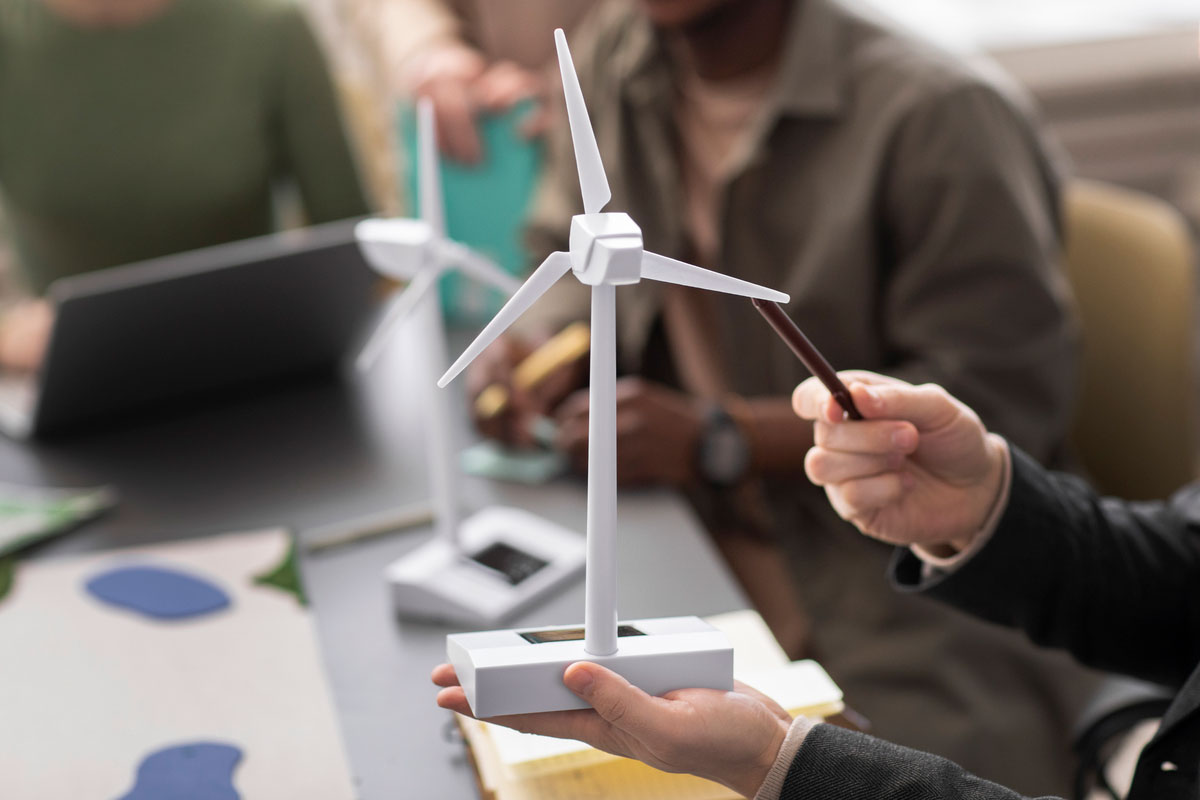
21. Green Insulation
Green insulation, a pioneering construction material, prioritizes environmental sustainability while fulfilling the critical role of providing insulation for buildings in the sustainable construction technologies industry. In contrast to traditional insulation materials like fiberglass or foam insulation, which can have detrimental effects on the environment and release harmful toxins into the atmosphere, green insulation materials are crafted from natural or recycled sources.
These materials exemplify a commitment to sustainability and ecological responsibility. One notable example is cellulose insulation, which is crafted from recycled newspapers and treated with fire-retardant chemicals to meet stringent safety standards. This eco-conscious choice not only ensures efficient insulation but also contributes to reducing the environmental footprint of construction.
GreenFiber Leading Manufacturer of Cellulose Insulation
GreenFiber Insulation is a pioneering company specializing in green insulation solutions. They produce cellulose insulation made from recycled newspaper and other cellulose sources. Their commitment to sustainability is evident in their products, which meet stringent safety standards while significantly reducing the environmental impact of construction. GreenFiber Insulation is known for its exceptional insulation properties and its dedication to eco-friendly building practices.
Retrofoam Development in Green Insulation
RetroFoam is a leading innovator in the field of green insulation materials based in Michigan. They have developed foam insulation products made from renewable soybean oil, replacing traditional petroleum-based foams. SoyFoam’s insulation not only boasts excellent thermal properties but is also biodegradable and minimizes environmental harm. Their approach exemplifies a commitment to sustainable construction technologies and reducing reliance on fossil fuels.
22. Micro Wind Turbines
Micro wind turbines are an innovative solution for harnessing renewable energy directly on-site. These compact turbines can be strategically installed on rooftops, harnessing the power of the wind to generate clean and sustainable electricity. By doing so, they reduce the dependence on grid-based electricity, offering a double advantage: lowering energy costs and promoting sustainability. These unobtrusive installations are becoming increasingly popular in both residential and commercial settings, reflecting a growing commitment to renewable energy sources and a reduction in carbon emissions.
SwiftWind Turbines Micro Wind Turbine Technology
SwiftWind Turbines is a pioneering company specializing in micro wind turbine technology. They have designed compact and efficient wind turbines that can be easily installed on rooftops. These turbines harness the power of wind to generate clean and renewable electricity, reducing dependence on grid-based power sources. SwiftWind’s innovations exemplify the commitment to sustainable energy generation and environmental responsibility.
Vertical Power Micro Wind Turbines
Vertical Power is another notable company in the micro wind turbine sector and the sustainable construction technologies industry. They offer innovative vertical-axis wind turbines that are designed for both residential and commercial applications. These turbines are known for their silent operation and high energy efficiency. Vertical Power’s technology represents a significant step toward reducing carbon emissions and increasing the availability of on-site renewable energy sources.
23. Smart Home Technology
Smart home technology represents a significant stride in the quest for sustainable and efficient residential living. It empowers homeowners with the ability to seamlessly manage their energy consumption. By monitoring and adjusting heating, cooling, lighting, and other essential systems, smart home technology ensures a more efficient and eco-conscious operation. This level of control not only enhances the comfort and convenience of homes but also significantly reduces energy waste, thereby reducing environmental impact and energy costs. Smart homes are emblematic of the modern commitment to responsible energy consumption and sustainability.
Nest Labs Smart Google
Nest Labs, a subsidiary of Google, is a prominent player in the smart home technology industry. They are renowned for their smart thermostats and other home automation devices that help homeowners monitor and control energy use. Nest’s products have become synonymous with eco-conscious living, as they enable more efficient and sustainable operation of heating, cooling, and other household systems.
Ecobee; Smart, Secure, Sustainable
Ecobee is a Canadian company known for its smart thermostats and smart home technology in the sustainable construction technologies industry. Their products not only enhance convenience but also help homeowners manage energy consumption more effectively. Ecobee’s commitment to sustainability is evident in their energy-saving solutions, making them a leading name in the smart home technology sector.
24. Rain Gardens
Rain gardens are a thoughtful and aesthetically pleasing addition to environmentally-conscious construction and landscaping in the sustainable construction technologies industry. These strategically designed gardens serve as natural reservoirs for capturing and absorbing rainwater runoff, effectively curbing erosion and pollution in nearby bodies of water. They can be seamlessly integrated into the architectural design of buildings or parking lots, playing a crucial role in managing stormwater runoff. By doing so, they promote sustainable drainage practices, minimize flooding risks, and contribute to the overall health of ecosystems. Incorporating rain gardens into construction projects aligns with the growing emphasis on responsible water management and environmental stewardship.
RAINscapeTO Offers Eco-Landscaping Services
As additional Indigenous employees join their team, the company will be able to construct a social enterprise that gradually integrates traditional Indigenous ecological knowledge and practices since it has a solid base in place. RAINscapeTO’s long-term objective is to develop into an Indigenous-led and-run social enterprise.
Through participation, education, and cooperative neighborhood projects, Toronto Green Community, a non-profit organization, has inspired and assisted diverse communities in creating an environmentally sustainable city since 1995. One of its programs is RAINscapeTO.
RainHarvest Systems Rain Solutions Design
RainHarvest Systems is a company that provides rain garden solutions, including rainwater harvesting systems, for construction projects. They specialize in designing and implementing rain gardens that efficiently capture and manage rainwater runoff, reducing erosion and pollution. RainHarvest Systems is at the forefront of sustainable drainage practices and eco-conscious construction.

Challenges and Solutions of Implementing Sustainable Construction Technologies
A review was undertaken to investigate and pinpoint the potential challenges faced by project management teams in sustainable construction technologies processes. From this thorough review, several primary challenges emerged.
These include elevated costs associated with sustainable building procedures and materials, intricacies within the construction process, protracted bureaucratic procedures, a lack of familiarity with sustainable technology, limited awareness, and the absence of comprehensive information regarding sustainable products.
1. Costs of Sustainable Building
Sustainable building processes and materials often come at a higher price, ranging from 1% to 25% more than traditional construction. These increased expenses are due to complex designs, eco-friendly practices, and the use of sustainable materials, which can cost 3–4% more. This puts pressure on project managers to stay within their budgets.
- Budget Planning: Include a sustainable construction technologies budget from the project’s inception to anticipate and manage higher costs effectively.
- Life Cycle Cost Analysis: Consider the long-term savings and benefits of sustainable materials and practices to justify the initial higher costs.
2. Construction Complexity
Sustainable construction can involve intricate technologies and processes, making it vital to communicate these complexities early on. Failing to do so may jeopardize the project’s success. Effective project management systems are essential to meet project objectives.
- Early Communication: Foster open communication among project stakeholders to ensure that everyone understands the complexities involved in sustainable construction technologies.
- Training and Education: Provide training and educational resources to project teams to improve their understanding of sustainable technologies and processes.
3. Bureaucratic Hurdles
Lengthy approval processes for new construction technologies can delay project completion. Navigating these bureaucratic obstacles poses challenges for project management.
- Streamlined Approval Processes: Work with local authorities and relevant bodies to streamline approval processes for sustainable construction technologies and practices.
- Advocacy and Lobbying: Advocate for changes in regulations and policies that could expedite approvals.
4. Lack of Sustainable Expertise
Many project management teams lack familiarity with sustainable construction materials and techniques. This knowledge gap can adversely impact project outcomes. Maintaining alignment between planned and actual performance is critical.
- Training Programs: Develop and implement training programs for project management teams to enhance their knowledge of sustainable construction.
- Consult Experts: Collaborate with experts in sustainable construction technologies to guide and support project teams.
5. Limited Awareness
Some builders resist sustainable construction technologies due to perceived risks and lack of understanding. Environmental audits, a beneficial practice, are often overlooked. Public education on the benefits of sustainability, particularly indoor conditions, productivity, and occupant health, is insufficient. This lack of awareness poses a significant challenge to sustainable building.
- Education Campaigns: Launch educational campaigns to inform builders, project managers, and the public about the benefits and advantages of sustainable construction technologies.
- Case Studies: Share success stories and case studies that demonstrate the positive impacts of sustainable building on indoor environmental quality, productivity, and occupant health.
6. Insufficient Information
Inadequate information about sustainable materials and construction processes complicates project management. Builders frequently rely on specialists for this knowledge. Additional challenges include risks related to various project delivery contracts, effective communication, team member interests, and the time required to implement sustainable practices on construction sites.
- Sustainable Product Directories: Create and maintain directories of sustainable products and materials to make it easier for project managers to source them.
- Contract Clauses: Include clear contract clauses that require the use of sustainable materials and construction practices in construction agreements.
- Integrated Project Delivery (IPD): Consider implementing Integrated Project Delivery methods that encourage collaboration and early involvement of all project stakeholders, which can help address communication and coordination challenges.
Conclusion
In conclusion, sustainability has rapidly taken center stage in the construction industry, driven by the urgent need to reduce environmental impact. Recent technological advancements have enabled the collection of crucial data on emissions and ecological factors, compelling construction companies to prioritize sustainability. The expansion of sustainability reporting requirements and mandatory disclosures by financial services firms underscores the industry’s commitment to sustainability.
Understanding the interplay between sustainability and construction technology is pivotal for staying competitive. Sustainable construction technologies go beyond emissions reduction and positive public relations; it has far-reaching consequences, affecting the environment, global community well-being, labor shortages, and future project outlooks.
For any company looking to thrive in the industry, investing in green construction is essential to the sustainable construction technologies industry. Green construction initiatives are pioneering innovations that reduce environmental footprints, save costs, enhance reputations, and yield cutting-edge structures. Additionally, these initiatives can address labor shortages and even attract young talent concerned about the environment.
Reducing waste and emissions translates directly to cost savings, optimizing resource utilization, and impressing clients and stakeholders who prioritize sustainability. The statistics support these trends, showing that green construction practices are not only environmentally responsible but also economically advantageous.
In this dynamic environment, construction companies can leverage various sustainable construction technologies, including 3D printing, integrated environmental assessments, construction robots, energy-efficient architecture, and sustainable construction materials, to transform the industry. Embracing these technologies is a decisive step towards a more sustainable, efficient, and competitive future for construction. The challenges, from cost considerations to bureaucratic hurdles, can be addressed through proactive planning, education, streamlined processes, and increased awareness.
Suggested article for reading:
Discovering the World’s Top 21 Sustainable Buildings
Top 7 Sustainable Architecture Projects
7 Best Construction Project Management Tools; 2025 Review
Resources:
Construction Placement | StartUs | ViewPoint | SAIT | Constructible | PlanRadar | Gordian | Black Buffalo 3D | Mobbot | Cercula | Hloov | Curvecrete | ROBOSURF | Eden Arc | Thermosphr | EcoBricks | Aisti | Sweelco | Offsight | Adaptis | Upcycling Forum | Our Ecolution | FenX | Advanced Autoponics | Natura | GenieVision | Virtual Building | GreenCo Roofs | Bauder Flat Roofs | SunTech Energy | SolTech | Tesla | AquaSavers | RainPure Systems | EcoMix Concrete | GreenStone Inc. | Enlightech Solutions | EcoLight Control | GAF Energy | SolarCity | AeroFarms | Sagegreenlife | WaterSmart Innovations | AquaSolutions | EcoMats | BioBrick Co. | GreenFiber | Retrofoam | SwiftWind Turbines | Vertical Power | Nest Labs | Ecobee | RAINscapeTO | RainHarvest Systems
For all the pictures: Freepik | Virginia’s SWCD | gb&d Magazine | Britannica

